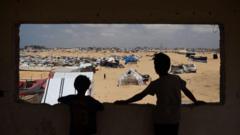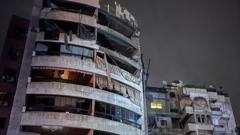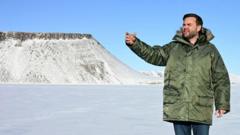Israel's strategic control over the Mount Hermon region marks a complex situation involving multiple international concerns and agreements.
Israeli Defense Forces Brace for Winter at Mount Hermon Amid Tensions

Israeli Defense Forces Brace for Winter at Mount Hermon Amid Tensions
Israeli troops are set to maintain their presence on Mount Hermon, with implications for regional security and UN relations.
The Israeli Defense Forces (IDF) are making preparations to establish a year-round presence at the peak of Mount Hermon, strategically located on the borders of Syria, Lebanon, and a United Nations-demilitarized zone in the Golan Heights. This directive from Israeli Defense Minister Israel Katz follows Israel's recent seizure of control over the area, a move which comes amid the turmoil of the Syrian civil war and associated political shifts.
In a public statement, Katz highlighted the significant security reasons behind this decision, pointing to the need to maintain vigilance in light of the evolving situation in Syria. A photo shared by Katz showed Prime Minister Benjamin Netanyahu surveying the region, symbolizing Israel's renewed stronghold after decades.
This act has attracted attention and concern from the United Nations, which has urged Israel to withdraw from the demilitarized zone, citing violations of Syria's sovereignty and the long-standing 1974 disengagement agreement that established the buffer zone. UN Secretary-General António Guterres emphasized that this agreement is still valid and criticized any measures contrary to it, calling for compliance from both nations involved.
Israel, however, defends its actions by claiming the agreement effectively lost its meaning following the weakening of the Syrian government. They argue that the current instability warrants heightened military readiness to preempt potential threats, particularly concerning the risk of weapon transfers to extremist groups.
Over the past week, Israel's military efforts reportedly included over 350 aerial strikes targeting Syrian military assets, attempting to thwart weapon proliferation. This aggressive stance raises questions about Israel's future interactions with both Syria and the UN and the potential for further conflict in a region already fraught with instability.
The backdrop to these developments includes Israel's historical annexation of the Golan Heights after capturing it during the 1967 Six-Day War—a move that has never received widespread international recognition, with the United States being a notable exception following its unilateral acknowledgment in 2019.
The complex tapestry of regional politics, historical grievances, and international regulations continues to shape events in Mt Hermon, impacting the lives of those in the surrounding areas and drawing concern from global observers.





















